Lynn McLaughlin's Blog
September 25, 2025
Why Student Well-Being Must Move from ‘Add-On’ to Core Practice in Schools
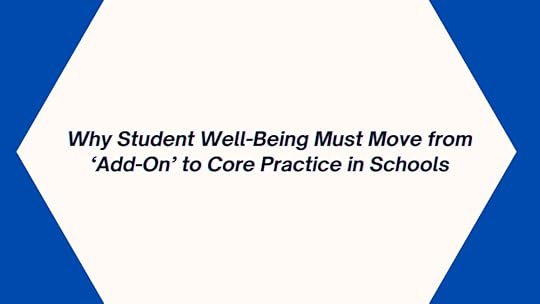
This article was also published on LInkedIn , authored by Lynn McLaughlin.
Introduction
Across classrooms worldwide, educators are asking: "How do we help children not just succeed academically, but thrive as human beings?"
The evidence is clear - student well-being is not a “nice-to-have,” add on to the curriculum, it’s essential. This research study is one of many I have posted on my website.
What the Research Shows
A systematic review and meta-analysis by Cipriano et al. (2023) analyzed dozens of school-based SEL programs. The findings are powerful:
💥 Universal programs boost student outcomes in social-emotional skills, behavior, and even academics.
💥 Benefits are long-lasting, when SEL is built into the culture of a school.
💥 Results are strongest when programs are delivered with fidelity - meaning staff are well-trained and supported.
What Needs to Be Done
The researchers are clear about the steps forward:
Adopt evidence-based SEL universally - every student should have access, not just those already struggling.
Invest in teacher training and coaching - give educators tools, strategies, and ongoing support.
Measure outcomes and fidelity - track both student progress and how well programs are being delivered.
Embed SEL into school culture - policies, daily routines, staff meetings, and classroom practices.
SEL must move from being a weekly “add-on” lesson to the foundation of how schools operate.
Why This Matters
When children learn to regulate emotions, problem-solve, and build relationships, everything else improves. The shift is about cultivating a whole-school culture of well-being.
💥 Classrooms are calmer.
💥 Teachers can focus more on learning.
💥 Students gain the resilience and empathy they need for life beyond school.
This isn’t just about education - it’s about preparing the next generation to navigate challenges with strength and compassion.
Conclusion
In my own work, I’ve seen how proactive schools that make well-being the priority transform classrooms and children.
The research confirms what many of us know: well-being is the foundation for learning. We have decades of evidence through peer reviewed, published research studies to support my quest to have it embedded in every curriculum.
August 2, 2025
Compiled Research References and Mental Health Change Agents
We are passionate about being proactive when it comes to children’s mental health. We have become accustomed to waiting for symptoms for our physical and mental health. We know much more than ever that children can learn strategies at a very young age and have them for life.
This page provides links to evidence based research and change-agents with expertise in child and youth mental health.
 What Does the Research Say?
Hundreds of independent studies confirm SEL benefits students … from casel
What Does the Research Say?
Hundreds of independent studies confirm SEL benefits students … from casel“The benefits of social and emotional learning (SEL) are well-researched, with evidence demonstrating that an education that promotes SEL yields positive outcomes for students, adults, and school communities.”
The findings are based on hundreds of independent studies across multiple fields and sources.
Simon Sinek Millennials in the Workplace Video Interview“Simon Sinek is an unshakable optimist. He believes in a bright future and our ability to build it together. Simon has devoted his life to help advance a vision of the world that does not yet exist; a world in which the vast majority of people wake up every single morning inspired, feel safe wherever they are and return home fulfilled at the end of the day. Every day is an opportunity to inspire someone.”
Wait Until 8thThe Wait Until 8th pledge empowers parents to rally together to delay giving children a smartphone until at least 8th grade. Banding together helps decrease the pressure to have a phone at an early age. Ten years old is the average age children get their first smartphone and the negative impacts are clear.
More than 50,000 parents have said yes to waiting on the smartphone for their families. Why we should wait, resources, research, smartphone alternatives and more are found on this site.
Science Daily - New Treatment For Childhood Anxiety Works by Changing Parent BehaviorExcerpt … click above for full article. “A study in the Journal of the American Academy of Child and Adolescent Psychiatry (JAACAP), published by Elsevier, reports that an entirely parent-based treatment, SPACE (Supportive Parenting for Anxious Childhood Emotions), is as efficacious as individual cognitive-behavioral therapy (CBT) for the treatment of childhood and adolescent anxiety disorders.”
Boston University: Moms Using Mobile Devices During Mealtime Interact Less With ChildrenAccording to the researchers, nonverbal interactions are a primary mode through which emotional content is communicated between parents and children, so its frequent displacement could represent a significant decrease in emotional connection. “We theorize that mobile device use was associated with a decreased number of maternal verbal and nonverbal interactions through decreased awareness of the child’s social cues while the mother’s gaze and/or attention was directed at a device,” explained corresponding author Jenny Radesky, MD, clinical instructor in Developmental-Behavioral Pediatrics at BUSM and a former fellow in pediatrics at Boston Medical Center.
ResearchGate - Jon Kabat-Zinn's Research While Affiliated With University of Massachusetts Medical School and Other PlacesJon Kabat-Zinn is an American professor emeritus of medicine and the creator of the 'Stress Reduction Clinic' and the 'Center for Mindfulness in Medicine, Health Care, and Society. This is a compilation of his research.
CAMH Research Impact Report 2019Excerpt.. Click above for the full report. “Compared with 15 years ago, there is now widespread public understanding that young people can experience depression and other mental illnesses, and that addressing mental health early is key, says Dr. Peter Szatmari. It has been shown that half of all cases of mental illness begin by age 14. Intervening in childhood and adolescence may prevent mental illness or lessen its impacts over a person’s lifetime.”
C hildren’s Mental Health Quarterly - Prevention: Reaching More KidsExcerpt “ne of the most effective ways to help children and youth is to reach them with prevention efforts before mental disorders develop. Yet to build prevention capacity and to reach more young people, approaches are needed that do not rely solely on direct provision by practitioners. We therefore aimed to identify effective self-directed prevention programs.”
Children’s Healthcare Canada - Child and Youth Mental HealthExcerpt… Click above for the full document “Research conducted by SickKids (2021) involving 350 children and youth reveals that over 70 per cent reported the pandemic had evoked symptoms of depression, anxiety, irritability, reduced attention span, hyperactivity, or obsessions. Among children identifying as visible minorities, almost 28 per cent reported poor mental health symptoms, and 30 per cent experienced symptoms consistent with “moderate” or “severe” generalized anxiety disorder.”
Child and Youth Mental Health in Canada - Library of Parliament Research PublicationsExcerpt … Click above for reference “This Background Paper briefly examines current mental health issues faced by young people in Canada, highlights the role of the federal government in addressing these challenges and describes some recent federal initiatives and investments.”
SickKids Releases New Research on How COVID-19 Pandemic has Impacted Child and Youth Mental, Physical HealthExcerpt … Click above for full document “While the COVID-19 pandemic has occurred in a series of waves, the heightened levels of depression and anxiety among children and youth seen at the start of the pandemic has remained consistent. This is one of many new preliminary findings from the ongoing COVID-19 mental health study led by The Hospital for Sick Children (SickKids). Taken together, the latest findings demonstrate a serious, sustained negative impact on the mental health of Ontario children, youth and their families.”
Excerpt … Click above for full volume Spring 2022. “How many children are affected by mental disorders? What are the most common disorders that children face? And what is the impact of these disorders? We address these and other questions in this overview.”
National Library of Medicine … The Importance of Early Bonding on the Long-Term Mental Health and Resilience of ChildrenExcerpt… Click above for full journal article “The evidence on the powerful role of loving nurture in the emotional, social and cognitive development of children is powerful. Parenting is therefore more important than we could ever have imagined.”
BMC Psychology - Mindfulness in Primary School Children as a Route to Enhanced Life Satisfaction, Positive Outlook and Effective Emotion RegulationExcerpt … Click above for full research article. “Taken together, this study provides preliminary evidence that the Living Mindfully Primary Programme is feasibly delivered by school staff, enjoyed by the children and may significantly improve particular components of wellbeing. Importantly, higher levels of mindfulness as a result of training may be related to effective emotional regulatory and cognitive reappraisal strategies.”
MINDFULNESS GOES TO SCHOOL: THINGS LEARNED (SO FAR) FROM RESEARCH AND REAL-WORLD EXPERIENCESExcerpt … Click above for full research article. “Limited research with youth has shown promise for the effectiveness of mindfulness-based programs in schools to improve attention and executive functioning, bolster social-emotional resiliencies, and help teachers and students manage school-related stressors. Many schools have begun to integrate these programs into their curricula…”
The Impact of Emotional Intelligence on Childhood Anxiety | Literature ReviewWe are at the core of an anxiety epidemic (Russell, 2014), with roughly 4.4 million (7.1%) of the world’s children diagnosed with anxiety, an increase from 5.5% in 2007 and 6.4% in 2012 (CDC, 2020). This phenomenon is on the rise. Additionally, one-third (37.9%) of children aged 3-17 diagnosed with anxiety have also been diagnosed with behaviour problems or depression (32.3%). Anxiety disorders, such as social phobia, separation anxiety, and generalized anxiety, are among the most common mental health affliction present in children (CDC, 2020; Elseviere, 2020; Polanczyk et al., 2015), often emerging before they reach eleven (CDC, 2020; Kesler et al., 2005; Reardon et al.,2018). Additionally, many children go undiagnosed (Russell, 2014), and only 59.3% of children aged 3-17 formally diagnosed with anxiety received treatment (CDC, 2020; Reardon et al., 2018). Childhood anxiety is distressful for both children and their families (Elsevier, 2020) and without early intervention and effective resources, anxiety will follow children into adulthood (Copeland et al., 2014), often resulting in adverse outcomes coupled with the related financial burden toll on society (Reardon et al., 2018). Therefore, it is essential, now more than ever, to develop resources for parents, teachers, and the like to assist in supporting anxious children (Klein, 2009). The evidence says it is important to speak openly about the realities of anxiety and educate children on how to tolerate anxiety to learn they can manage their anticipatory fears (Goldstein, n.d.). Children turn to their parents for support and guidance in managing things that scare them (Elsevier, 2020), and the modern contemporary parent will seek resources to help them (Russell, 2014). Literature can provide techniques for facing anxiety is a practical, enjoyable way for guardians looking to teach their anxious children how to cope with life’s struggles. The act of reading out loud with children can be soothing for anxious children (Barr, 2020), and when a guardian is involved in the healing process, it leads to more robust skill development (Brendel, 2011). The content of literature can provide children with the vocabulary and self-awareness needed to understand and express themselves in an otherwise tricky circumstance (Barr, 2020). Ultimately, developing a series of children’s books that offer evidence-based approaches to coping with everyday situations known to cause anxiety in children would be beneficial for children, guardians, and society.
ReferencesBarr, A. (2020, October 29). How Reading Aloud Can Help Children with Anxiety. Demme Learning. https://demmelearning.com/reading-aloud-children-anxiety .
Brendel, K. E. (2011). A systematic review and meta-analysis of the effectiveness of child-parent interventions for children and adolescents with anxiety disorders (Order No. 3454900). Available from ProQuest Dissertations & Theses Global. (871109324). Retrieved from https://search-proquest-com.ledproxy2.uwindsor.ca/dissertations-theses/systematic-review-meta-analysis-effectiveness/docview/871109324/se-2?accountid=14789
Centers for Disease Control and Prevention (CDC). (2020, June 15). Data and Statistics on Children's Mental Health. Centers for Disease Control and Prevention. https://www.cdc.gov/childrensmentalhealth/data.html .
Copeland, W. E., Angold, A., Shanahan, L., & Costello, E. J. (2014). Longitudinal patterns of anxiety from childhood to adulthood: The great smoky mountains study. Journal of the American Academy of Child & Adolescent Psychiatry, 53(1), 21–33. https://doi.org/10.1016/j.jaac.2013.09.017
Elsevier. (2020, April 2). New treatment for childhood anxiety works by changing parent behavior. ScienceDaily. Retrieved February 12, 2021 from www.sciencedaily.com/releases/2020/04/200402110133.htm
Goldstein, C. (n.d.). What to Do (and Not Do) When Children Are Anxious. Child Mind Institute.
Kessler RC, Chiu WT, Demler O, Walters EE. Prevalence, Severity, and Comorbidity of 12-Month DSM-IV Disorders in the National Comorbidity Survey Replication. Arch Gen Psychiatry. 2005;62(6):617–627. doi:10.1001/archpsyc.62.6.617
Klein, R. (2009). Anxiety disorders. Journal of Child Psychology and Psychiatry, 50(1‐2), 153–162. https://doi.org/10.1111/j.1469-7610.2008.02061.x
Polanczyk, G., Salum, G., Sugaya, L., Caye, A., & Rohde, L. (2015). Annual research review: A meta-analysis of the worldwide prevalence of mental disorders in children and adolescents. Journal of Child Psychology and Psychiatry, 56(3), 345–365. https://doi.org/10.1111/jcpp.12381
Reardon, T., Spence, S., Hesse, J., Shakir, A., & Creswell, C. (2018). Identifying children with anxiety disorders using brief versions of the Spence Children’s Anxiety Scale for children, parents, and teachers. Psychological Assessment, 30(10), 1342–1355. https://doi.org/10.1037/pas0000570
Russell, A. (2014, december 16). Today’s children struggle with major anxiety [ Video]. Youtube. https://www.youtube.com/watch?v=JEyWsa-mblc
Current Opinion in Pediatrics - Mindfulness-Based Interventions for Adolescent HealthExcerpt “Research has shown positive effects of mindfulness across several health conditions commonly encountered during adolescence. Mindfulness-based Interventions can reduce symptoms of anxiety and depression.”

March 3, 2025
Celebrating 150 Episodes of Taking the Helm Podcast: A Milestone Moment with Erin Plumb
 listen link
listen link As we mark a major milestone in the journey of Taking the Helm, I’m filled with gratitude and excitement! Our 150th episode is here, and we couldn’t be more thrilled to celebrate this achievement with none other than Erin Plumb, a recognized leader in assistive technology, accessibility, and inclusion. Erin’s insights on the role of technology in supporting learners both inside and outside the classroom provide an inspiring and timely conversation that speaks to the heart of what this podcast is all about: empowering children and youth to thrive.
Reflecting on the Journey: 150 Conversations of ImpactReaching 150 episodes wouldn’t have been possible without the incredible guests who have joined me on this journey. From educators, parents, and mental health experts to innovators and advocates, each guest has shared their wisdom, stories, and strategies to help shape a better future for our children and young people. By helping all of us see things from a different perspective, we each are learning new strategies and finding resources so we can be well ourselves and model for our children and students. Every episode has been a building block in the mission to promote proactive strategies for emotional well-being, resilience, and the importance of mental health and inclusion.
I’m truly grateful to each person who has taken the time to share their expertise and experience on Taking the Helm. Your voices have inspired, challenged, and motivated our listeners—parents, educators, and anyone committed to the well-being of children and youth. Together, we’ve worked toward a shared vision: empowering those who nurture the next generation, whether in classrooms or homes, with the tools to guide them toward success and emotional resilience.
Don’t Miss Our 150th EpisodeThis milestone episode with Erin Plumb is not just a celebration of the past but a nod to the future of education, accessibility, and inclusion. As an expert in assistive technology, Erin has spent over 20 years helping to remove barriers for students with diverse learning needs. Her work is shaping the future of how we approach digital equity, inclusivity, and the powerful role technology plays in fostering educational opportunities for all learners.
In this episode, Erin dives deep into:
💥 What assistive technology is and why it’s critical in today’s digital world.
💥 How assistive tech supports students in areas like reading, writing, math, and STEM programs.
💥 The pros and cons of using technology in the classroom, with insights on how it can help educators and students with special needs.
💥 Apps and tools that can make learning more accessible for all.
💥 How to embrace AI safely in schools and the exciting potential of future developments in assistive technology.
💥 Guidelines to help parents choose the right apps for their children which are secure and meet their developmental and cognitive needs.
This conversation is essential for educators, parents, and anyone involved in the education space. Erin’s insights will empower you with knowledge on how to better support learners, especially those with special needs, using the latest technology.
A Heartfelt Thank You to Our Guests and ListenersAs we reflect on the 150 episodes of Taking the Helm, I want to take a moment to thank all of our guests. Your voices have been a beacon of inspiration, and your willingness to share your knowledge has made this podcast a truly valuable resource for parents, teachers, and anyone working to improve the lives of children and youth. Together, we’ve created a space for meaningful conversations that spark change.
To our loyal listeners: thank you for being part of this journey. Your support and engagement keep this podcast going, and I’m so grateful for the opportunity to connect with you. I hope you continue to find value in every episode, and I encourage you to share these conversations with your networks—because when we share knowledge, we empower change.
A Special Thank You to Kathryn CollinsI’d also like to extend a heartfelt thank you to Kathryn Collins, who has been graciously guest-hosting the podcast and this milestone episode. Kathryn’s passion for inclusive education and her thoughtful approach to every conversation made this episode even more special. Having Kathryn as a collaborator on Taking the Helm has been such a joy, and I’m incredibly grateful for her contributions and insight.
Join Us for Our 150th CelebrationIf you haven’t tuned in yet, now is the perfect time! Listen to our 150th episode with Erin Plumb on your favourite podcast app on March 12th.
Also, feel free to explore all 150 episodes on my website, where you can search by guest name or topic to find episodes that resonate with you. And, of course, don’t forget to subscribe on your favorite podcast app so you never miss a show.
Thank you again to every guest, every listener, and every person who has helped shape the Taking the Helm podcast. Here’s to the next 150 episodes of growth, learning, and empowering the leaders of tomorrow.
November 13, 2024
In-Powerment: Digging Deep into How Families Can Truly Thrive
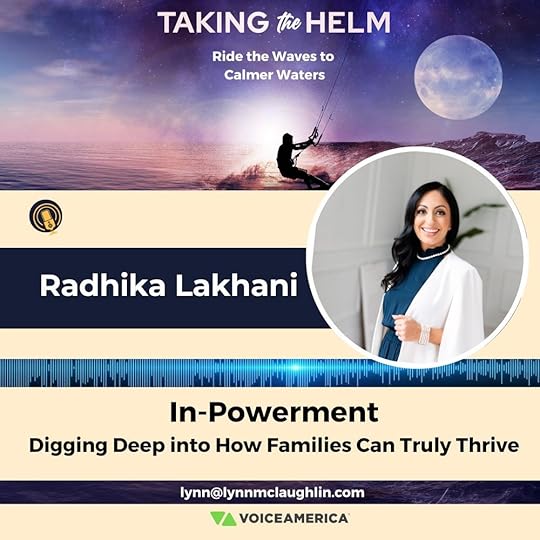
This press release was published KINGSVILLE, AZ, UNITED STATES, October 7, 2024 /EINPresswire.com/
Taking the Helm podcast presents a 1:1 interview with Radhika (aka Rad) Lakhani, an accomplished attorney, coach, and thought leader in conscious lawyering. Rad shares her deeply personal journey from professional success to spiritual awakening, revealing how life's greatest challenges shaped her mission to guide others toward living their most epic lives.
Interview Highlights:
• Pain Pushes You Until Vision Pulls You – A reflection on Dr. Brian Weiss' profound teachings and how this wisdom helped Rad navigate her own path.
• From Bay Street to Private Practice – Discover how Rad transitioned from a successful corporate law career to listening to her heart’s call for a more meaningful life.
• Conscious Lawyering – Learn about this revolutionary approach and its life-changing impact on Rad’s clients.
• Overcoming Personal Armageddon – Rad opens up about the heartbreaking loss of her son at birth and how this devastating experience led her to ask the biggest question of her life—and receive a life-altering answer.
• The Pillars of an Epic Life – Rad outlines the foundational principles that allow us to truly thrive.
• The Power of Silence – Exploring why quieting the mind is an essential yet underrated tool for personal growth.
• Family Thriving – Rad reveals the three essential pillars parents and children need to thrive together.
• The Impact of Meditation – A deep dive into different meditation techniques and the powerful influence Dr. Joe Dispenza’s work had on Rad’s ability to break through personal barriers and unlock her next level of potential.
Rad shares valuable tools for those seeking personal transformation, conscious parenting, and a balanced life. https://www.voiceamerica.com/
About Radhika Lakhani Esq., LLM JD:
Radhika (aka: Rad) Lakhani Esq., LLM JD, is an expert in human conflict resolution and relationship dynamics. She has thousands of hours of experience as a divorce lawyer, mediator, children’s lawyer, court appointed dispute resolution officer, and educator. In 2022, after almost 20 years in law and ADR, Rad transitioned from family law lawyer to family IN-powerment educator.
Rad’s mission is to help families experience greater peace and harmony. She believes that when parents and children are IN-powered, with the right tools, they not only resolve their own conflict, but begin to truly THRIVE. Rad believes that every child deserves to be raised in a peaceful home.
Rad left law to help families heal conflict at the ROOT (which she realized the legal system is not designed to do). Over her years as a lawyer, Rad routinely shared mindfulness and self-development tools that had helped her get through her own massive life challenges. Over time her clients said that they were “life-changing”. She realized that instead of trying to “control” conflict, we need to raise awareness around the sources of conflict and help people resolve conflict “from within.”
Her experimental group-courses led to dozens of clients stating that they felt more empowered, less anxious, happier, & more at peace in 1-2 months. The results were incredible, and better yet, they were starting to positively impact her client’s children.
Rad's clients have called her their “life guru”, “Yoda” and “soul activator.” Her desire is to help people transform their greatest challenges into their greatest miracles, to help them experience rapid transformation with greater ease, and provide a new pathway for families to resolve conflict in a lasting and empowering way.
https://www.consciousnesswithrad.com/
About Lynn Mclaughlin
Lynn McLaughlin has served in many roles as an educator … Superintendent, Principal, Vice-Principal, Teacher, and Educational Consultant in a board of over 35,000 students. Lynn's professional speaking experiences have been local, provincial, and international. She is passionate about children's emotional well-being and what we as adults must do to ensure our children have the skills, mindset, and strategies to be successful and happy in today's world.
As a best-selling and award-winning author, Lynn has now teamed up with her niece, Amber Raymond, to co-author a children's book series titled, "The Power of Thought." Both are passionate about being proactive when it comes to children's mental health. They are visiting school communities both virtually and in-person, offering professional development for teachers as well as information evenings for parents and guardians titled, “Heart Matters, Embracing Emotional Health for All.
Lynn has hosted the podcast, Taking the Helm for over four years and is proud to bring the voices of others forward to learn and with and from. Dedicated to community causes, Lynn is a member of 100 Women Who Care Windsor/Essex and is a Rotarian and is a brain tumour survivor.
https://lynnmclaughlin.com/
About Taking the Helm:
Wednesdays 7 am PST on the Voice America Health and Wellness Channel, once per month.
Being emotionally well means we understand, accept and can manage our feelings effectively through times of change or challenge. Many children and youth are struggling in this complex world. We've become accustomed to waiting for symptoms before we seek help for our mental or physical health care. Imagine the synergy we can create by learning and modelling proven strategies, so children learn to manage their feelings from a young age. We're Taking the Helm with a proactive mindset to give kids a head start towards developing a positive quality of life, healthy social and problem-solving skills, self-regulation, confidence, and empathy.
Sandra Rogers
VoiceAmerica
+1 480-553-5756
July 19, 2024
Discover the GRIT Advantage: Lynn McLaughlin and Haze Schepmyer Unveil Strategies to Foster Guts in Children and Youth
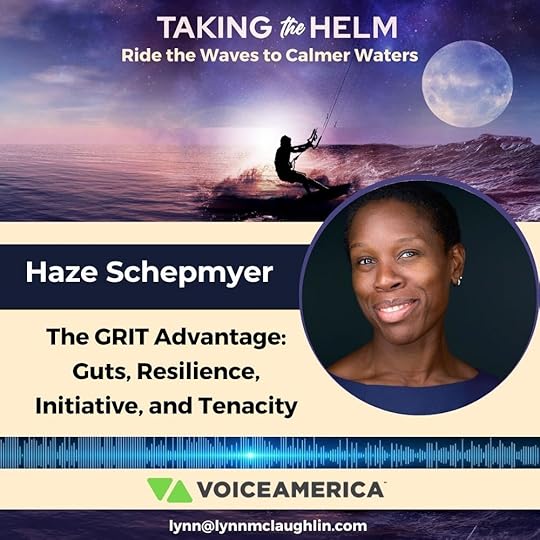
This press release was posted on Presswire 17 July 2024
KINGSVILLE, AZ, UNITED STATES, July 17, 2024 /EINPresswire.com/ -- Have you discovered your own GRIT or recognized how important it is to know, show and sow not only your own, but teach your children how to do the same? Host Lynn McLaughlin is joined by Haze Schepmyer, a Life-Event Transition Consultant dedicated to helping individuals transition from surviving to thriving through life events.
What is GRIT and who’s got it? Discover the essence of GRIT and the characteristics of those who possess it.
Why is it important to know your GRIT? Reflect on Buddha's wisdom: "All that we are is the result of what we have thought," and learn why self-awareness of your GRIT matters.
How do you grow and show your GRIT? Inspired by William James' insight, "Our greatest weapon against stress is our ability to choose one thought over another," understand the significance of nurturing your GRIT. Embrace Eckhart Tolle's belief that "Awareness is the greatest agent for change," and see how demonstrating your GRIT can inspire transformation.
Why should we sow our GRIT? Learn about the impact of modeling and nurturing GRIT as parents, guardians, mentors, role models, teachers, and community members.
What’s the GRIT game? Uncover the engaging and practical aspects of the GRIT game, a tool to instill resilience and perseverance in the younger generation.
https://www.voiceamerica.com/episode/...
About Haze Schepmyer,
Following the unexpected loss of her dream job in 2019, Haze founded Grow My GRIT to spark powerful conversations about facing life's challenges with resilience.
She emphasizes reframing thoughts to focus on personal strengths and resources during tough times. Haze created the GRIT Growth Guide, a tool that helps people understand, develop, and demonstrate their GRIT both personally and professionally. Her GRIT framework has supported individuals of all ages in finding meaningful ways to thrive through life's transitions.
We delve into the incredible value of GRIT, especially for children and youth. Haze will explore the essential elements of GRIT and why understanding, developing, and demonstrating it is crucial in today's world.
Visit Haze at: https://growmygrit.com/media-sheet
About Lynn Mclaughlin
Lynn McLaughlin has served in many roles as an educator … Superintendent, Principal, Vice-Principal, Teacher, and Educational Consultant in a board of over 35,000 students. Lynn's professional speaking experiences have been local, provincial, and international. She is passionate about children's emotional well-being and what we as adults must do to ensure our children have the skills, mindset, and strategies to be successful and happy in today's world.
As a best-selling and award-winning author, Lynn has now teamed up with her niece, Amber Raymond, to co-author a children's book series titled, "The Power of Thought." Both are passionate about being proactive when it comes to children's mental health. They are visiting school communities both virtually and in-person, offering professional development for teachers as well as information evenings for parents and guardians titled, “Heart Matters, Embracing Emotional Health for All.
Lynn has hosted the podcast, Taking the Helm for over four years and is proud to bring the voices of others forward to learn and with and from. Dedicated to community causes, Lynn is a member of 100 Women Who Care Windsor/Essex and is a Rotarian and is a brain tumour survivor.
About Taking the Helm
Wednesdays 7 am PST on the Voice America Health and Wellness Channel, once per month.
Being emotionally well means we understand, accept and can manage our feelings effectively through times of change or challenge. Many children and youth are struggling in this complex world. We've become accustomed to waiting for symptoms before we seek help for our mental or physical health care. Imagine the synergy we can create by learning and modelling proven strategies, so children learn to manage their feelings from a young age. We're Taking the Helm with a proactive mindset to give kids a head start towards developing a positive quality of life, healthy social and problem-solving skills, self-regulation, confidence, and empathy.
About VoiceAmerica
VoiceAmerica is the original digital broadcast company for the production and delivery of Live Internet Talk Radio programming and continues to be the industry leader in digital media, marketing, and distribution. We are the pioneers of digital radio programming and have been since 1999. We create and distribute over 500 unique and innovative radio programs for our millions of engaged listeners worldwide. Our network channels distribute live programs daily that reach a growing domestic and international audience who connect through all devices via our mobile, desktop, and tablet VoiceAmerica destinations. Learn more at http://www.voiceamerica.com. Follow us on Facebook, Instagram, LinkedIn and Twitter. Call us any time to find out how VoiceAmerica can help you reach your audience, (480) 553-5756.
Sandra Rogers
VoiceAmerica
+1 4805535756
email us here
June 7, 2024
GUEST BLOG BY Jackie Simmons | You Can’t Tell by Looking
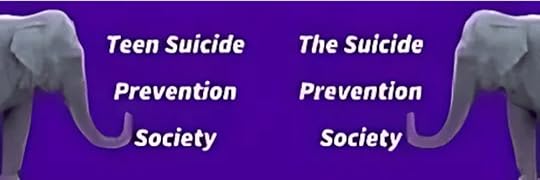 Content Warning: Suicide
Content Warning: Suicide This guest post was written by Jackie Simmons, Founder of the Suicide Prevention Society. She is an international speaker, the host of The Suicide Prevention Show, the co-founder of the Teen Suicide Prevention Society, and the author/compiler of the book: Make It A Great Day: The Choice Is Yours and author of The “Why Not?” Workbook: Breaking the Silence on Teen Suicide.
“We imagine a world where suicide is a thing of the past.”
__________________________________________
You Can’t Tell By Looking
You hadn't laughed so hard in years.
She was the life of the party last night.
A mutual friend calls.
You smile as you answer until you hear her tears.
“She's gone” she cries.
What?
“She's gone! After the party she went home and . . .
”At the funeral all you heard was: "How could this have happened? We didn't see it coming"
We've learned you can't tell by looking.
That's why it's important to talk about suicide now, before you think they need it.
Get your free guide to the talk that saves lives.
__________________________________________
Watch Jackie Simmons, TEDx Speaker’s, “Have the Talk to Stop Teen Suicide” talk.
"In the next 24 hours, over 3,000 American teens will attempt to take their own lives. According to the Center for Disease Control, 25% of American young adults are struggling with suicidal thoughts. When you watch Have “The Talk” to Stop Teen Suicide, you’ll enter into a world of deadly silences and bone-chilling revelations. Along the way, Have The Talk to Stop Teen Suicide delivers the clues and keys you need to break the deadly silences and prevent the guilt-nightmare that haunts parents, classmates, teachers, and friends following a suicide attempt. Have “The Talk” to Stop Teen Suicide includes the purely preventative, science-based, 4-step script for The Talk About Suicide. It’s a powerful model for communicating on a topic no one wants to talk about. Jackie believes having The Talk About Suicide just might save your child’s life. Jackie Simmons, - Jackie@TeenSuicidePreventionSociety.org – is an international speaker, the host of The Suicide Prevention Show, the co-founder of the Teen Suicide Prevention Society, and the author/compiler of the book: Make It A Great Day: The Choice Is Yours and author of The “Why Not?” Workbook: Breaking the Silence on Teen Suicide. Jackie believes that teen suicides can be prevented. This is truly a case where an ounce of prevention is worth way more than a pound of cure. "
GUEST BLOG BY Jackie Simmons | you can’t tell by looking
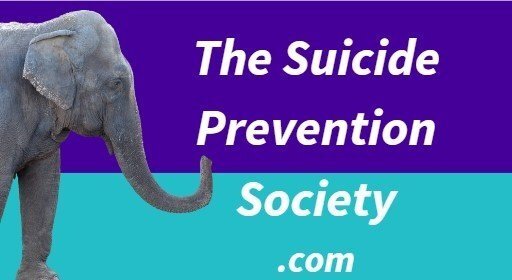 Content Warning: Suicide
Content Warning: Suicide This guest post was written by Jackie Simmons, Founder of the Suicide Prevention Society. She is an international speaker, the host of The Suicide Prevention Show, the co-founder of the Teen Suicide Prevention Society, and the author/compiler of the book: Make It A Great Day: The Choice Is Yours and author of The “Why Not?” Workbook: Breaking the Silence on Teen Suicide.
“We imagine a world where suicide is a thing of the past.”
__________________________________________
You Can’t Tell By Looking
You hadn't laughed so hard in years.
She was the life of the party last night.
A mutual friend calls.
You smile as you answer until you hear her tears.
“She's gone” she cries.
What?
“She's gone! After the party she went home and . . .
”At the funeral all you heard was: "How could this have happened? We didn't see it coming"
We've learned you can't tell by looking.
That's why it's important to talk about suicide now, before you think they need it.
Get your free guide to the talk that saves lives.
__________________________________________
Watch Jackie Simmons, TEDx Speaker’s, “Have the Talk to Stop Teen Suicide” talk.
"In the next 24 hours, over 3,000 American teens will attempt to take their own lives. According to the Center for Disease Control, 25% of American young adults are struggling with suicidal thoughts. When you watch Have “The Talk” to Stop Teen Suicide, you’ll enter into a world of deadly silences and bone-chilling revelations. Along the way, Have The Talk to Stop Teen Suicide delivers the clues and keys you need to break the deadly silences and prevent the guilt-nightmare that haunts parents, classmates, teachers, and friends following a suicide attempt. Have “The Talk” to Stop Teen Suicide includes the purely preventative, science-based, 4-step script for The Talk About Suicide. It’s a powerful model for communicating on a topic no one wants to talk about. Jackie believes having The Talk About Suicide just might save your child’s life. Jackie Simmons, - Jackie@TeenSuicidePreventionSociety.org – is an international speaker, the host of The Suicide Prevention Show, the co-founder of the Teen Suicide Prevention Society, and the author/compiler of the book: Make It A Great Day: The Choice Is Yours and author of The “Why Not?” Workbook: Breaking the Silence on Teen Suicide. Jackie believes that teen suicides can be prevented. This is truly a case where an ounce of prevention is worth way more than a pound of cure. "
May 15, 2024
STUDENT MENTAL HEALTH: FROM REACTION TO PREVENTION

Introduction
In today’s fast-paced educational settings, educators face a growing challenge that goes beyond mere academics: the mental and emotional well-being of their students. Classrooms are becoming microcosms of the larger world, reflecting increased anxiety, stress, and isolation among students. As a lifelong educator with experience from kindergarten through post-secondary, and entrepreneur whose focus is on emotional health for children and youth, I have witnessed firsthand the urgent need for proactive strategies in emotional education. The children's book series, "The Power of Thought," is designed to address these very challenges, providing educators and students alike with the tools they need to manage emotions effectively.
The Struggles in the Classroom
Educators are increasingly observing students who either react explosively to stress or withdraw entirely, demonstrating behaviors that disrupt their learning and social interactions. But why do these emotional outbursts or retreats happen?
Overwhelming Stress and Pressure: Students today face immense pressure to perform academically and socially, which can lead to stress overload. This is often compounded by a lack of adequate coping mechanisms.
Lack of Emotional Vocabulary: Many students struggle because they do not have the language to express what they are feeling. Without the words to describe their emotions, these feelings can manifest as behavioral issues.
Their Toolbox is Empty: When students can identify and understand the reason for their feelings, they need to know what to about it. There are many proven strategies they have not learned and practiced, giving them coping mechanisms.
Isolation and Loneliness: In an age where digital interactions often replace face-to-face connections, feelings of isolation are prevalent. This can be particularly acute in environments where students feel they do not belong or are not understood.
Are Educators Equipped with Proactive Emotional Resources?
Despite the availability of educational resources aimed at emotional regulation, many educators have not integrated these tools into their daily teaching practices. The reasons vary, including:
Curriculum Constraints: Teachers often face strict curriculum guidelines that prioritize academic results over emotional learning, or the curriculum they are bound to does not include well-being at all.
Training and Support: Implementing programs on emotional well-being requires proper training and ongoing support, which may not always be readily available.
Lack of Awareness: Some educators may not be fully aware of the resources available or understand how they can be woven into the curriculum.
The Role of "The Power of Thought" in Transforming Well-Being
Books are not only used in primary classrooms to ignite a love of reading but also for educational purposes. "The Power of Thought" series has been developed in consultation with educators, parents and clinicians. It offers a proactive approach for children to learn about emotional regulation from a young age. Each book takes readers into a situation they can relate to, where characters glow in the colour of their feelings. A proven strategy that students can use for life is then taught in a fun way. Here’s how this resource can make a difference:
Supports Educators: It equips teachers with ready-to-use materials that can be easily integrated into their teaching schedule, helping them address emotional learning without overwhelming their existing workload. Staff and students have a tool box of strategies to use throughout the year.
Empowers Students: Armed with better emotional coping strategies, students can handle stress more effectively, leading to improved academic performance and healthier social interactions.
Creates Inclusive Environments: By teaching all children about emotional regulation, the series promotes an inclusive environment where every student feels valued and understood.
Builds Emotional Intelligence: The series provides children with relatable stories and practical tools that help them identify and manage their emotions, fostering emotional intelligence that is critical in today’s world.
Invitation to Explore Further
Educators who are keen to see a transformation in their classrooms where students are equipped not just academically but also emotionally are invited to explore how "The Power of Thought" can be part of their teaching toolkit. Educational guides, think-tank pages and puppets accompany the books.
Together, we can equip our future generations with the resilience and emotional acuity needed to thrive in a complex world.
April 20, 2024
GUEST BLOG BY ANGELA LEGH | Unraveling the Epidemic of Loneliness: A Call for Real Connection in a Digital Age

This guest post was written by Angela Legh for the NYC Independent. Angela is an International Freelance Author, an International Bestselling Author, and Motivational Speaker.
In a recent report by the US Surgeon General, recommendations were laid out for parents and caregivers, highlighting the importance of fostering healthy social connections for young people. While these suggestions are undoubtedly valuable, they only scratch the surface of a much deeper problem.
The Challenges Presented by Social Media
The report issued by the Surgeon General fails to address the insidious nature of social media, where comparison and validation-seeking behaviors run rampant. It’s not enough to simply delay the age at which children join these platforms or monitor their screen time. We must equip them with the critical thinking skills to navigate the digital landscape responsibly and discern between meaningful connections and superficial interactions.
We must acknowledge the detrimental impact of social media and the lack of emotional literacy among today’s youth. Loneliness can stem from the craving for external validation, where one’s sense of self-worth depends on how others perceive them. This notion manifests in believing that “I am good only if you see me as good.”
If a teen’s need for validation goes unfulfilled, the teen may experience heightened feelings of inadequacy, loneliness, and even depression. This reliance on external validation from social media can perpetuate a cycle of seeking approval from others rather than fostering genuine self-confidence and inner validation. As a result, the teen may struggle to develop authentic relationships and find themselves increasingly disconnected from their true selves and those around them.
Seeking external validation can signify a disconnection from oneself that can trace its roots back to unresolved childhood wounds. Childhood trauma, whether it’s emotional neglect, physical abuse, or other forms of adversity, can leave deep emotional scars that linger into adulthood. Feelings of shame, guilt, and inadequacy stemming from these experiences can be overwhelming and difficult to face head-on, so we often bury them deep within our subconscious.
Individuals may seek validation and approval from external sources to numb the pain of these buried emotions. Alternatively, they may seek relief through numbing behaviors, such as alcohol, drugs, or self-harming behavior. Whether it’s through seeking validation from others or engaging in self-destructive behaviors, the person who chooses these coping mechanisms is carving a path toward increased emotional pain. If you notice any of these behaviors in your teens, it’s crucial to seek assistance from a professional.
The temporary relief gained from external validation only perpetuates the cycle of disconnection from oneself. True healing can only begin when we dare confront and acknowledge the buried emotions from our past. Through therapy, self-reflection, and compassionate self-care, we can gradually unearth these suppressed feelings and begin the process of healing and self-reconnection.
By facing our childhood wounds with courage and compassion, we can reclaim our sense of self-worth and break free from the cycle of seeking external validation. Doing so paves the way for genuine self-acceptance, inner peace, and authentic connection with ourselves and others.
Building Meaningful Connections Offline
Investing in solid relationships and encouraging offline, real-world interactions are crucial to combating loneliness. Volunteering to help others can forge deep, compassionate relationships as individuals come together to impact their communities. A few things can lift one’s spirit, such as volunteering to assist those in need. Whether it’s lending a hand at a local soup kitchen or participating in community service projects, the act of giving back fosters bonds based on shared values and a sense of purpose.
Similarly, joining clubs and sports teams offers opportunities to build bonding relationships. Whether it’s a book club, a hobby group, or a sports team, being part of a collective pursuit fosters a sense of belonging and camaraderie, where shared experiences and challenges deepen connections among members. Through these activities, individuals combat loneliness and cultivate a sense of belonging and interconnectedness within their communities, contributing to the collective well-being of society as a whole.
Another avenue for teens to establish offline connections is attending local events or workshops tailored to their interests, such as art exhibitions, music concerts, or educational seminars. If necessary, parents can collaborate with other parents to organize transportation and guidance for their teens. These gatherings provide opportunities for teens to mingle with others who share their interests, facilitating connections beyond their existing social circles.
Listening Compassionately
Most importantly, we must listen to the voices of our youth. Let us validate their experiences of loneliness and isolation without dismissing them as trivial or fleeting. Let us offer them the support and resources they need to navigate these turbulent waters and emerge stronger, more resilient, and truly connected to themselves and others.
Ultimately, it’s about more than the number of friends or followers we have online but the depth and authenticity of the connections we cultivate offline. The quality of life is measured by the quality of the relationships we sustain.
It’s time for parents to reflect on the impact of their own social media usage and the importance of fostering real-world connections and social interactions as a model of behavior for their children. My heart sinks when I see a parent on a playground, glued to their phone, scrolling through Instagram while the child begs for attention. At that moment, the parent misses out on genuine interaction, opting for the illusion of connection through social media. Take a moment to observe how parents in your community engage with social media. Let’s unite to fight against teenage loneliness, working toward a future where every adolescent feels acknowledged, heard, and valued for their individuality and worth.
Angela Legh is passionate about promoting emotional intelligence with her book series The Bella Santini Chronicles.While we live in a hyper-connected world, there is a paradox in how loneliness continues to plague the lives of teenagers. Despite the apparent plethora of online friends and social media followers, many adolescents are trapped in a web of isolation, yearning for genuine human connection.
Unraveling the Epidemic of Loneliness: A Call for Real Connection in a Digital Age

This guest post is written by Angela Legh for the NYC Independent. Angela is an International Freelance Author, an International Bestselling Author, and Motivational Speaker.
In a recent report by the US Surgeon General, recommendations were laid out for parents and caregivers, highlighting the importance of fostering healthy social connections for young people. While these suggestions are undoubtedly valuable, they only scratch the surface of a much deeper problem.
The Challenges Presented by Social Media
The report issued by the Surgeon General fails to address the insidious nature of social media, where comparison and validation-seeking behaviors run rampant. It’s not enough to simply delay the age at which children join these platforms or monitor their screen time. We must equip them with the critical thinking skills to navigate the digital landscape responsibly and discern between meaningful connections and superficial interactions.
We must acknowledge the detrimental impact of social media and the lack of emotional literacy among today’s youth. Loneliness can stem from the craving for external validation, where one’s sense of self-worth depends on how others perceive them. This notion manifests in believing that “I am good only if you see me as good.”
If a teen’s need for validation goes unfulfilled, the teen may experience heightened feelings of inadequacy, loneliness, and even depression. This reliance on external validation from social media can perpetuate a cycle of seeking approval from others rather than fostering genuine self-confidence and inner validation. As a result, the teen may struggle to develop authentic relationships and find themselves increasingly disconnected from their true selves and those around them.
Seeking external validation can signify a disconnection from oneself that can trace its roots back to unresolved childhood wounds. Childhood trauma, whether it’s emotional neglect, physical abuse, or other forms of adversity, can leave deep emotional scars that linger into adulthood. Feelings of shame, guilt, and inadequacy stemming from these experiences can be overwhelming and difficult to face head-on, so we often bury them deep within our subconscious.
Individuals may seek validation and approval from external sources to numb the pain of these buried emotions. Alternatively, they may seek relief through numbing behaviors, such as alcohol, drugs, or self-harming behavior. Whether it’s through seeking validation from others or engaging in self-destructive behaviors, the person who chooses these coping mechanisms is carving a path toward increased emotional pain. If you notice any of these behaviors in your teens, it’s crucial to seek assistance from a professional.
The temporary relief gained from external validation only perpetuates the cycle of disconnection from oneself. True healing can only begin when we dare confront and acknowledge the buried emotions from our past. Through therapy, self-reflection, and compassionate self-care, we can gradually unearth these suppressed feelings and begin the process of healing and self-reconnection.
By facing our childhood wounds with courage and compassion, we can reclaim our sense of self-worth and break free from the cycle of seeking external validation. Doing so paves the way for genuine self-acceptance, inner peace, and authentic connection with ourselves and others.
Building Meaningful Connections Offline
Investing in solid relationships and encouraging offline, real-world interactions are crucial to combating loneliness. Volunteering to help others can forge deep, compassionate relationships as individuals come together to impact their communities. A few things can lift one’s spirit, such as volunteering to assist those in need. Whether it’s lending a hand at a local soup kitchen or participating in community service projects, the act of giving back fosters bonds based on shared values and a sense of purpose.
Similarly, joining clubs and sports teams offers opportunities to build bonding relationships. Whether it’s a book club, a hobby group, or a sports team, being part of a collective pursuit fosters a sense of belonging and camaraderie, where shared experiences and challenges deepen connections among members. Through these activities, individuals combat loneliness and cultivate a sense of belonging and interconnectedness within their communities, contributing to the collective well-being of society as a whole.
Another avenue for teens to establish offline connections is attending local events or workshops tailored to their interests, such as art exhibitions, music concerts, or educational seminars. If necessary, parents can collaborate with other parents to organize transportation and guidance for their teens. These gatherings provide opportunities for teens to mingle with others who share their interests, facilitating connections beyond their existing social circles.
Listening Compassionately
Most importantly, we must listen to the voices of our youth. Let us validate their experiences of loneliness and isolation without dismissing them as trivial or fleeting. Let us offer them the support and resources they need to navigate these turbulent waters and emerge stronger, more resilient, and truly connected to themselves and others.
Ultimately, it’s about more than the number of friends or followers we have online but the depth and authenticity of the connections we cultivate offline. The quality of life is measured by the quality of the relationships we sustain.
It’s time for parents to reflect on the impact of their own social media usage and the importance of fostering real-world connections and social interactions as a model of behavior for their children. My heart sinks when I see a parent on a playground, glued to their phone, scrolling through Instagram while the child begs for attention. At that moment, the parent misses out on genuine interaction, opting for the illusion of connection through social media. Take a moment to observe how parents in your community engage with social media. Let’s unite to fight against teenage loneliness, working toward a future where every adolescent feels acknowledged, heard, and valued for their individuality and worth.
Angela Legh is passionate about promoting emotional intelligence with her book series The Bella Santini Chronicles.While we live in a hyper-connected world, there is a paradox in how loneliness continues to plague the lives of teenagers. Despite the apparent plethora of online friends and social media followers, many adolescents are trapped in a web of isolation, yearning for genuine human connection.



